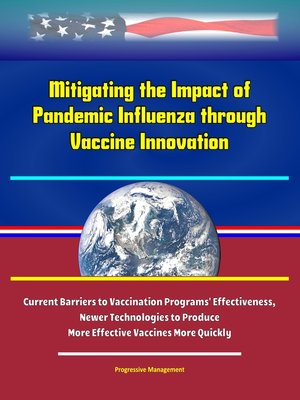Mitigating the Impact of Pandemic Influenza through Vaccine Innovation
ebook ∣ Current Barriers to Vaccination Programs' Effectiveness, Newer Technologies to Produce More Effective Vaccines More Quickly

Sign up to save your library
With an OverDrive account, you can save your favorite libraries for at-a-glance information about availability. Find out more about OverDrive accounts.
Find this title in Libby, the library reading app by OverDrive.



Search for a digital library with this title
Title found at these libraries:
| Loading... |
This is a report issued in September 2019 by the White House Council of Economic Advisers. This report estimates the potentially large health and economic losses in the United States associated with influenza pandemics and discusses why the most commonly used vaccine production technologies are unlikely to mitigate these losses. We estimate the value of new vaccine technologies that would make vaccines available more quickly and likely improve their effectiveness in moderating the risks of pandemics. We discuss why private market incentives may be insufficient to develop new vaccine technologies or promote the uptake of existing, faster but more expensive technologies, despite their large expected value to society. And we argue that increased utilization of, and investment in, these new technologies—along with public-private partnerships, to spur innovation—may be valuable to decrease the impact of both pandemic and seasonal influenza.
Every year, millions of Americans suffer from seasonal influenza, commonly known as "the flu," which is caused by influenza viruses. A new vaccine is formulated annually to decrease infections resulting from the small genetic changes that continually occur in the most prevalent viruses and make them less recognizable to the human immune system. There is, however, a 4 percent annual probability of pandemic influenza resulting from large and unpredictable genetic changes leading to an easily transmissible influenza virus for which much of the population would lack the residual immunity that results from prior virus exposures and vaccinations. The Council of Economic Advisors (CEA) finds that in a pandemic year, depending on the transmission efficiency and virulence of the particular pandemic virus, the economic damage would range from $413 billion to $3.79 trillion. Fatalities in the most serious scenario would exceed half a million people in the United States. Millions more would be sick, with between approximately 670,000 to 4.3 million requiring hospitalization. In a severe pandemic, healthy people might avoid work and normal social interactions in an attempt to avert illness by limiting contact with sick persons. By incapacitating a large fraction of the population, including individuals who work in critical infrastructure and defense sectors, pandemic influenza could threaten U.S. national security.
This compilation includes a reproduction of the 2019 Worldwide Threat Assessment of the U.S. Intelligence Community.






